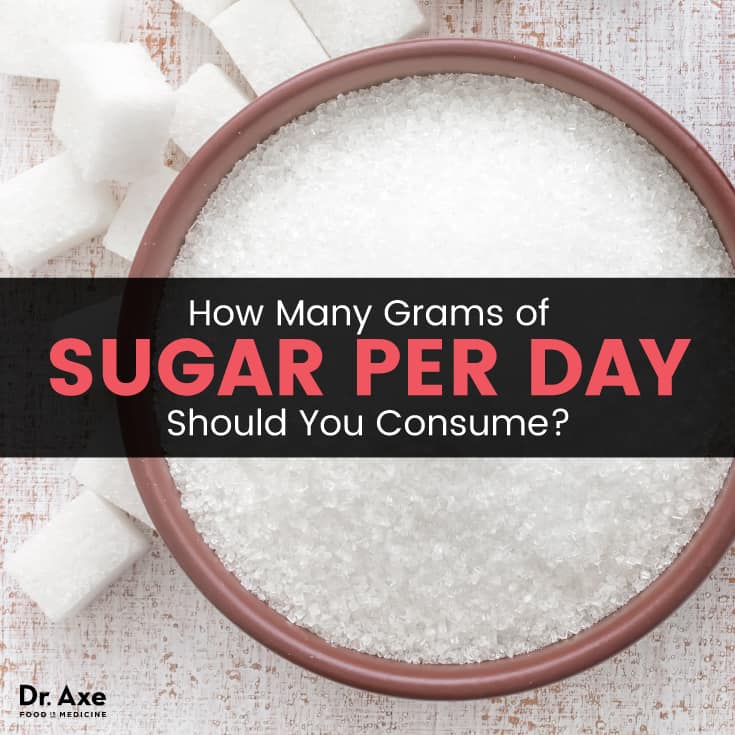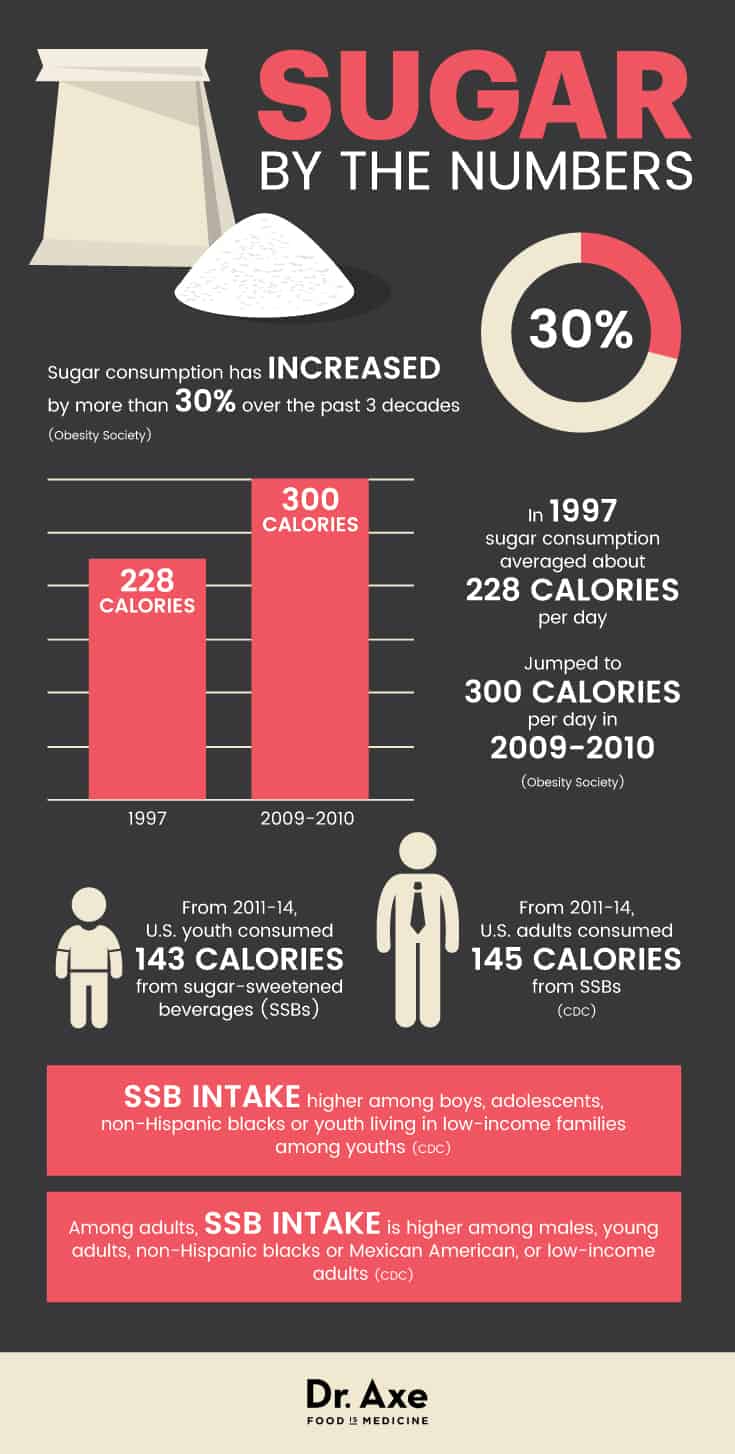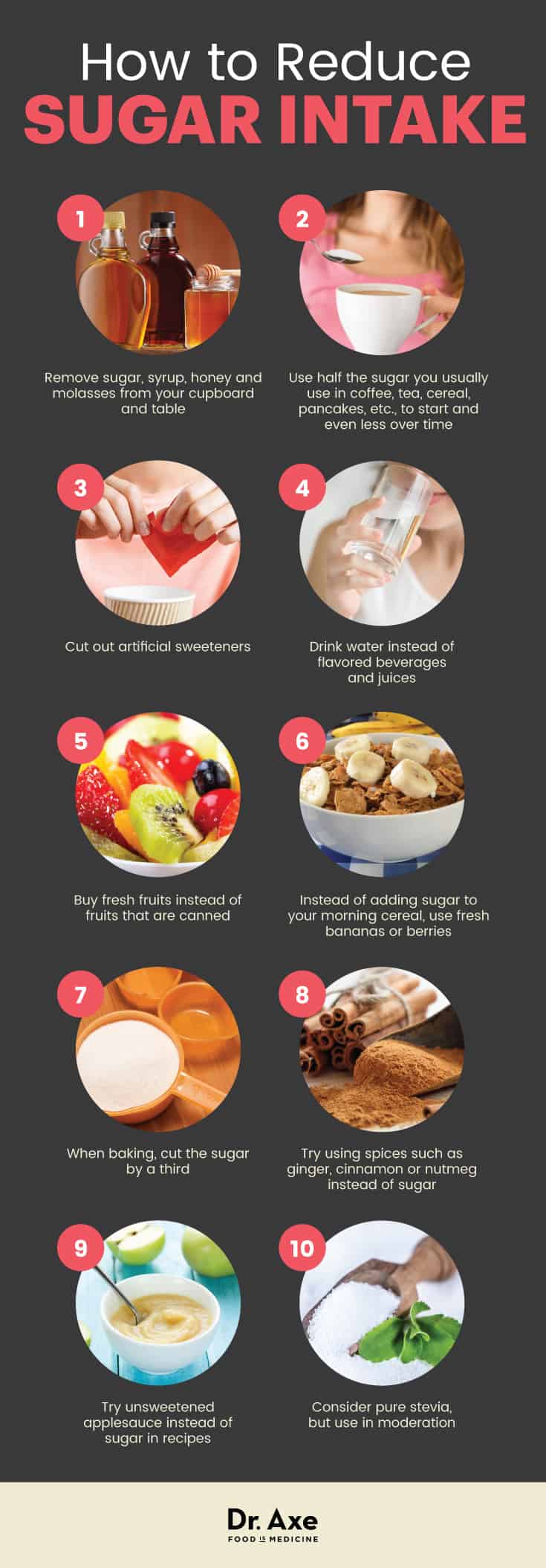
Sugar has gotten a bad rap and for good reason. It’s in almost every packaged food you pick up at the grocery store, and there seems to be quite a sugar addiction epidemic in the United States. If you don’t see the word “sugar” in the ingredients list, there is likely another form of it that you simply do not recognize. Given what we know about sugar intake and the health problems the wrong amount can cause, how many grams of sugar per day should we consume?
It seems our taste buds have adapted to the desire to crave sugar, and if our food has not been sweetened with it, it doesn’t taste nearly as good to many people. There is an upside here: Taste buds can adapt so you don’t crave all that sugar, but how? Read on to learn all about how to reduce sugar, along with with how many grams of sugar per day you should actual consume for optimal health.
How Many Grams of Sugar Per Day Should You Consume?
The American Heart Association recommends most American women eat to no more than 100 calories per day of sugar (six teaspoons or 20 grams) and no more than 150 calories per day for men (or about nine teaspoons or 36 grams). (1)
To put that into perspective, one teaspoon is equal to four grams of sugar. An eight-ounce glass of orange juice has 5.5 teaspoons of sugar. That’s equal to over 20 grams. That’s why you want to eat your fruit; don’t drink it. Another option is to cut the juice by using half water and half juice, while drinking a total of four to six ounces — not eight to 12. And keep in mind that most bottled juices and beverages contain two servings per individual bottle. Don’t ignore the label.
Let’s not forget about the kids. How many grams of sugar per day should they consume? Children do not need so much sugar, yet it’s in everything. Sugar consumption for children should not go beyond three teaspoons of sugar per day, which equates to 12 grams. Did you know that one cup of Fruit Loops contains 3.75 teaspoons of sugar? That’s over the recommended amount for kids. Now you know why most cereals are not the best choice for anyone.
You now have a sense of just how much sugar per day you should consume, but how do you track your sugar intake? The best way is to keep a journal. There are lots of online trackers you can use, and they’re especially helpful in cases when there is no nutritional information on the label or in the case of whole foods, such as fresh fruit.
Sugar Consumption in the U.S.
Let’s delve into what sugar is all about and just how much sugar is too much. According to the American Heart Association, there are two types of sugars found in our diets. There are those that are truly natural that come from foods like fruit and vegetables, and there are added sugars and artificial sweeteners, such as those little blue, yellow and pink packets (a BIG no-no) found at the coffee stand; white sugar; brown sugar; and even chemically manufactured sugars like high fructose corn syrup. These added sugars are ingredients that are in foods like soft drinks, fruit drinks, candy, cakes, cookies, ice cream, sweetened yogurt, and grains like waffles, many breads and cereals. (2)
Some common names for added sugars or foods with added sugars are:
- Agave
- Brown sugar
- Corn sweetener
- Corn syrup
- Fruit juice concentrates
- High fructose corn syrup
- Honey
- Invert sugar
- Malt sugar
- Molasses
- Raw sugar
- Sugar
- Sugar molecules ending in “ose” (dextrose, fructose, glucose, lactose, maltose, sucrose)
- Syrup
Now that you have a good idea about added sugars, what about those naturally occurring ones from fruit? Do they count? Well, sort of. Yes, those are better choices, but some foods are high in sugar so you still want to keep that in check if you’re diabetic or suffer from some sugar sensitive diseases.
It’s better to have the whole fruit, but choosing the right fruit is important. A medium-sized orange contains about 12 grams of natural sugar. A cup of strawberries contains about half that. Dried fruit and whole fruit contain about the same, calorie and sugar wise, but you lose a lot of hydration benefits due to the loss of water during the dehydration process. (3, 4)
Some foods are simply lower in sugar content so if watching your waistline is a key factor, where your sugar comes from may make a difference. However, both the orange and strawberries are low in calories and nutrient-dense, containing three grams of fiber, 100 percent of the recommended daily consumption for vitamin C, folic acid, potassium and more. If you opt for that 20-ounce can of soda, here’s what you get instead: 225 calories, zero nutrients and 60 grams of added sugar, probably as high fructose corn syrup. Which one sounds more appealing? The soda or the strawberries?
Regardless, having sugar from real food is the way to go since it contains fructose, which is great for energy. When sugar has been extracted from foods, you’re left with zero fiber and the nutrient density is greatly depleted. Go for the real thing — and no that’s not Coca-Cola. (5, 6)
The Obesity Society reports that sugar consumption has increased by more than 30 percent over the past three decades. In 1977 sugar consumption averaged about 228 calories per day but jumped to 300 calories in 2009–2010, and it may be higher now with children consuming even more. These added sugars, which are placed in sauces, breads and pastas, in addition to excessive amounts in sweets, beverages and cereals, put unnecessary calories into the diet and cause inflammation, disease and more. While it may increase energy briefly, it greatly reduces much-needed nutrients.
Studies indicate that the reduction of sugar can make a big difference in our health, particularly regarding type II diabetes and obesity. Advocates suggest that by implementing a cap-and-trade policy, sugar emissions by food manufacturers can be reduced at a rate of 1 percent per year, which may reduce the rate of obesity by 1.7 percentage points and the incidence of type 2 diabetes by 21.7 cases per 100,000 people over 20 years. This may reduce health care spending by nearly $9.7 billion. (7)
The Centers for Disease Control and Prevention has some more stats on how much sugar Americans consume: (8)
- From 2011-14, U.S. youth consumed 143 calories and adults consumed 145 calories from sugar-sweetened beverages (SSBs).
- SSB intake higher among boys, adolescents, non-Hispanic blacks or youth living in low-income families among youths.
- Among adults, SSB intake is higher among males, young adults, non-Hispanic blacks or Mexican American, or low-income adults.

Can You Have Too Little Sugar? Dangers of Low Sugar
Low sugar can result in a good bit of discomfort, especially if you suffer from diabetes. Low blood glucose, also known as hypoglycemia, is one of the most common problems associated with low blood sugar and is defined as a blood glucose level below 70 mg/dl. Often, it’s associated with medicine, not enough food or not eating for long periods of time, too much activity, and sometimes alcohol. (9, 10)
Symptoms may include feeling shaky, sweaty and having a racing heart. It’s usually mild, but severe hypoglycemia may develop into mental confusion, antagonistic behaviors, unconsciousness or seizures.
Low blood sugar can affect anyone, and checking it regularly may be a way to monitor it. The frequency of testing varies, but most people who have diabetes test their blood sugar levels before breakfast, lunch, dinner and again before bed. Seeing a doctor is important if you suspect you have problems with low blood sugar. Your physician can help your body get to and maintain normal blood sugar levels. (11)
Dangers of High Sugar
While not having enough sugar can cause hypoglycemia, on the flip side, you can have too much sugar. That’s called hyperglycemia and may cause serious complications, such as: (12)
- Cardiovascular disease
- Nerve damage known as neuropathy
- Kidney damage
- Diabetic neuropathy
- Damage to the blood vessels of the retina, diabetic retinopathy, which could cause blindness
- Cataracts or clouding in the eyes
- Problems with the feet caused by damaged nerves or poor blood flow
- Bone and joint problems
- Skin problems, including bacterial infections, fungal infections and non-healing wounds
- Infections in the teeth and gums
- Diabetic ketoacidosis
- Hyperglycemic hyperosmolar syndrome
There are more dangers of high sugar as well, which is why it’s vital to know how many grams of sugar per day you should consume.
1. Too Much Sugar May Cause Heart Problems
The JAMA reports that, in some cases, nearly one third of calories consumed per day come from sugar. Boy, is that a lot of sugar! The National Health and Nutrition Examination Survey gathered information that helped identify issues with too much sugar. The results indicate that most U.S. adults consume more added sugar than is recommended for a healthy diet, resulting in a higher risk cardiovascular disease mortality. (13)
2. Sugar Can Cause Diabetes, Obesity and Metabolic Syndrome
Diabetes is probably one of the most common problems with excessive sugar and is happening at staggering rates across the United States and beyond due to dietary changes, such as more processed foods, refined sugars and less daily activity. When we consume too much sugar, the liver does all it can to convert the sugar into energy, but it can only do so much. Since it cannot metabolize all sugar that it receives if in excess, it then develops an insulin resistance, which can result in metabolic syndrome. (14)
3. Too Much Sugar Can Affect Your Teeth
Yes, it’s true that too much sugar can cause you to make a lot of trips to the dentist office. According to the American Dietetic Association and the Surgeon General’s report Oral Health in America, what you eat greatly affects your mouth — teeth and gums included. Too much sugar can cause bacterial growth, resulting in decay and infections of surrounding tissues and bone. (15)
4. Sugar May Hurt Your Liver
A diet high in sugar may cause problems with your liver, according to the American Diabetes Association. (16) How it works is that when you eat a moderate amount of sugar, in any form, it’s stored in the liver as glucose until the body needs it for various organs to function properly, such as the brain. But if you have too much, the liver simply cannot store it all. What happens? The liver is overloaded so it turns the sugar into fat.
While sugar from natural sources, such as fruit, is far better than the fake, processed version, the liver doesn’t quite know the difference. Additionally, a condition known as nonalcoholic fatty liver disease may be caused by excessive consumption of soft drinks, which develops insulin resistance and increased oxidative stress to the liver. On the other hand, if the body does not get enough sugar, it will use fat to supply energy. This is known as ketosis. (17, 18)
5. Sugar May Cause Cancer
Yes, it’s true that sugar can cause cancer. Studies show that obesity may be linked to death from most cancers due to what’s known as the insulin/insulin-like growth factor system and may enhance tumor cell growth. As well, metabolic syndrome, in association with chronic inflammation, may cause tumor growth and progression.
According to a study published in Integrative Cancer Therapies, there is a link between insulin and its effects on colon, prostate, pancreatic and breast cancer. It seems that sugar can even get in the way of cancer therapy, causing it to be less effective. By consuming more nutrients and less sugar, regularly exercising, and reducing stress, it’s possible to lower the risk of cancer and developing tumors. (19)
On the plus side, the right sugar and right amount of it may help athletes. While we know that carbs, such as bananas, can help aid in both performance and recovery of athletes, it seems that there is a smarter way to ensure performance and recovery.
Research indicates that some forms of sugar are better than others. Subjects were evaluated after a 90-minute swim or a 24-hour period of fasting. The results showed that fructose is not the best choice for replenishing, but by using both glucose and fructose, glycogen is more rapidly restored in the liver, which can help repair overworked muscles and lead an athlete to being more prepared for the next workout. (20)
High Sugar and Hidden Sugar Foods
Some foods are obvious sugar loads, but many foods may not be so obvious. If you want to know which foods have hidden sugar, read the labels. And, as always, eating real food in its original form, such as a piece of fruit instead of fruit juice, is better.
- Sports drinks, sodas
- Chocolate milk
- Cakes, pies and doughnuts, pastries
- Candy
- Flavored coffees
- Iced tea
- Cereals
- Granola bars
- Protein bars/energy bars
- Ketchup, BBQ sauce and other sauces
- Spaghetti sauce
- Yogurt
- Frozen dinners
- Dried fruits
- Fruit juices and other beverages, such as Vitamin Water
- Wine
- Canned fruits
- Canned baked beans
- Breads
- Cereals
- Smoothies
- Energy drinks
How to Reduce Sugar Intake
Reducing sugar intake is not as hard as you think, but if you’re addicted, it can take some practice and commitment just like any change. The American Heart Association shares some great tips on how to reduce sugar. Put these ideas into practice on a regular basis, and in no time, you will reduce sugar and reduce your risk of diabetes, heart disease, metabolic syndrome and obesity. (21)
- Remove sugar, syrup, honey and molasses from your cupboard and table.
- If you use sugar in your coffee, tea, cereal, pancakes, etc., cut back. Use half the amount you usually use to start and even less over time. And no artificial sweeteners!
- Drink water instead of flavored beverages and juices.
- Buy fresh fruits instead of fruits that are canned, especially those in syrups.
- Instead of adding sugar to your morning cereal, use fresh bananas or berries.
- When baking, cut the sugar by one third. Just try it! You probably won’t even notice.
- Try using spices, such as ginger, cinnamon or nutmeg, instead of sugar.
- Try unsweetened applesauce instead of sugar in recipes.
- Consider pure stevia, but use in moderation. It’s very sweet, so you don’t need much.

Precautions/Side Effects
As noted above, if you’re diabetic or have any symptoms that suggest you are diabetic, have a heart problem, cancer or any disease, make an appointment with your doctor right away. Sugar, among other things, can make matters worse. Getting the proper diagnosis and then consuming a diet rich in nutrients and less sugar can offer amazing benefits to your health.
Additionally, sugar can cause liver problems and obesity. Your doctor and a nutrition expert can help you make positive changes in your diet by limiting sugar and adding nutrient-rich foods.
Final Thoughts on How Many Grams of Sugar Per Day You Should Consume
Sugar is in everything so buyer beware. It can be avoided simply by making the right choices. Most foods do not need sugar to taste good. Take the time to learn how to cook without it.
Cooking at home can help reduce sugar consumption. Find recipes, such as those on my website, that contain little or no sugar. While it may seem awkward at first, if you stick to it, it becomes easy and you will be come a sugar-identifying expert.
As far as how many grams of sugar per day you should consume, the American Heart Association recommends most American women eat to no more than 100 calories per day of sugar (six teaspoons or 20 grams) and no more than 150 calories per day for men (or about nine teaspoons or 36 grams). And overall, added sugar should be less than 10 percent of your diet.
Read Next: Is Sugar Bad for You? Here’s How It Destroys Your Body
From the sound of it, you might think leaky gut only affects the digestive system, but in reality it can affect more. Because Leaky Gut is so common, and such an enigma, I’m offering a free webinar on all things leaky gut. Click here to learn more about the webinar.
Source: Dr Axe

